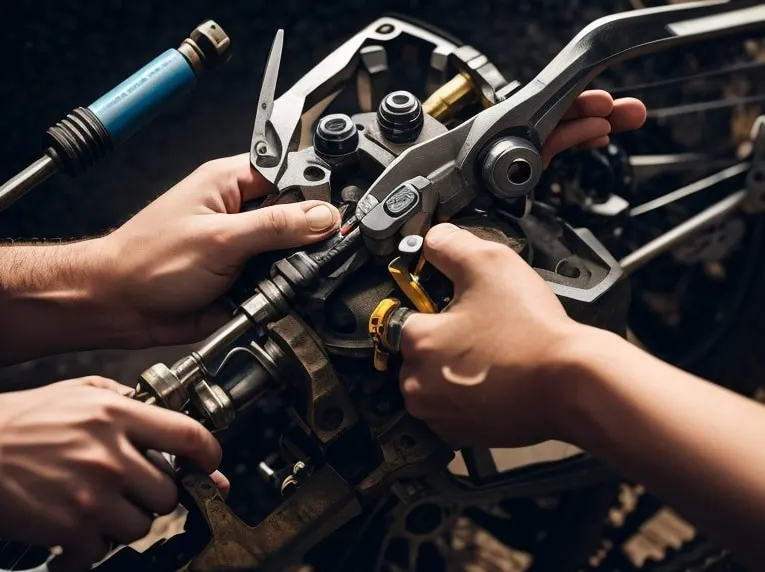Did you know that having properly functioning brakes is crucial for ensuring a safe and enjoyable dirt bike riding experience?
Well, if you’re like me and you want to improve your dirt bike brakes, then you’ve come to the right place! In this article, I’ll guide you through the process of bleeding your brake system step by step.
Now, you might be wondering why you need to bleed your brakes in the first place. Over time, air can get trapped in the brake lines, decreasing their effectiveness.
By bleeding the brakes, you’ll be able to remove any air bubbles and restore your brake system to its optimal performance.
But don’t worry, you don’t need to be a professional mechanic to tackle this task. With just a few basic tools and a little bit of know-how, you’ll be able to improve your dirt bike brakes all on your own.
So, let’s get started and make sure your brakes are in top-notch condition for your next off-road adventure!
Why Bleed Brakes?
There are several reasons why bleeding brakes is necessary:
- Improving performance: Bleeding the brakes helps to remove air bubbles that can lead to brake failure. When air enters the brake system, it can cause the brakes to feel spongy and less responsive. By bleeding the brakes, you can ensure that only brake fluid is in the system, resulting in brakes that feel more solid and reliable.
- Checking for debris or contaminants: Bleeding the brakes also provides an opportunity to inspect the system for any debris or contaminants that could affect brake performance. This step is crucial as any foreign substances in the brake system can compromise its effectiveness and safety.
Overall, bleeding the brakes is a simple yet important process that significantly enhances the effectiveness and safety of your dirt bike brakes.
Tools Needed

Having the right tools will make the brake bleeding process smoother and more efficient. It’s important to use a see-through hose, preferably a fuel hose, to easily monitor the flow of brake fluid and prevent air from entering the system.
By attaching the hose to the back brake nipple and ensuring it reaches the bottom of the brake fluid bottle, you can prevent any air bubbles from being sucked in. This will help improve the performance of your dirt bike’s brakes and ensure a safer riding experience.
Step-by-Step Process
To begin the step-by-step process, gather all the necessary tools for bleeding the brake system on a dirt bike. Make sure you have a see-through hose, preferably a fuel hose, and attach it to the back brake nipple.
Remove the cap and place a bottle of brake fluid nearby, ensuring that the hose reaches the bottom of the bottle to prevent air from being sucked in.
Once you have all the tools ready, follow these steps:
Step
- Fill the brake system completely with the recommended brake fluid, checking the cap for the specific type to use. Avoid air bubbles in the system.
- Pump the brakes a few times, then hold the brake down without releasing it. Unscrew the nipple using a size eight tool, and you should start to see fluid and bubbles coming out. Close the nipple and repeat the process until the brakes improve.
- Monitor the brake fluid level and refill it when it reaches halfway or decreases. Avoid overfilling to prevent spills. Regularly fill up the fluid during the bleeding process.
By following these steps, you’ll be able to bleed your dirt bike’s brake system effectively and improve its performance.
Key Takeaways
- Brake bleeding is essential for better brake performance on all types of dirt bikes, with a focus on the back brakes in this video.
- The necessary tools for brake bleeding include a see-through hose, a bottle of brake fluid, and a size eight tool.
- Bleeding the brake system involves filling it completely with the recommended brake fluid, pumping the brakes, unscrewing the nipple to allow fluid and bubbles to come out, and repeating the process until the brakes improve.
- Monitoring the brake fluid level, clearing air bubbles from the system, topping up brake fluid without overfilling, and testing the brakes for improved performance are important steps in the process.
Frequently Asked Questions
How often should I bleed my dirt bike brakes?
I recommend bleeding your dirt bike brakes every 6-12 months, or whenever you notice a decrease in performance.
Regular brake bleeding helps maintain optimal brake function and ensures your safety on the trails. So, don’t wait too long, and keep those brakes in top shape!
Can I use any type of hose for bleeding my brake system?
No, using a see-through hose, preferably a fuel hose, is recommended for bleeding your brake system on a dirt bike. This helps prevent air from being sucked in and allows you to monitor the fluid and air bubbles.
What can happen if I overfill the brake fluid?
If I overfill the brake fluid, it can lead to spills and mess. It’s important to leave space for the cap to be put back on and avoid contact with the paint. Any spilled brake fluid should be wiped off immediately.
Is it necessary to remove the cap while bleeding the brakes?
No, it is not necessary to remove the cap while bleeding the brakes. The cap should be kept on to prevent air from entering the system, ensuring a successful brake bleeding process.
Can I use a different type of brake fluid than the one recommended in the article?
No, it is not recommended to use a different type of brake fluid than the one recommended in the article. Using the recommended brake fluid ensures proper performance and safety of the brake system.
Previous Article: How To Adjust A Dirt Bike Chain
Next Article: Choosing The Perfect Budget-Friendly Beginner Dirt Bike

